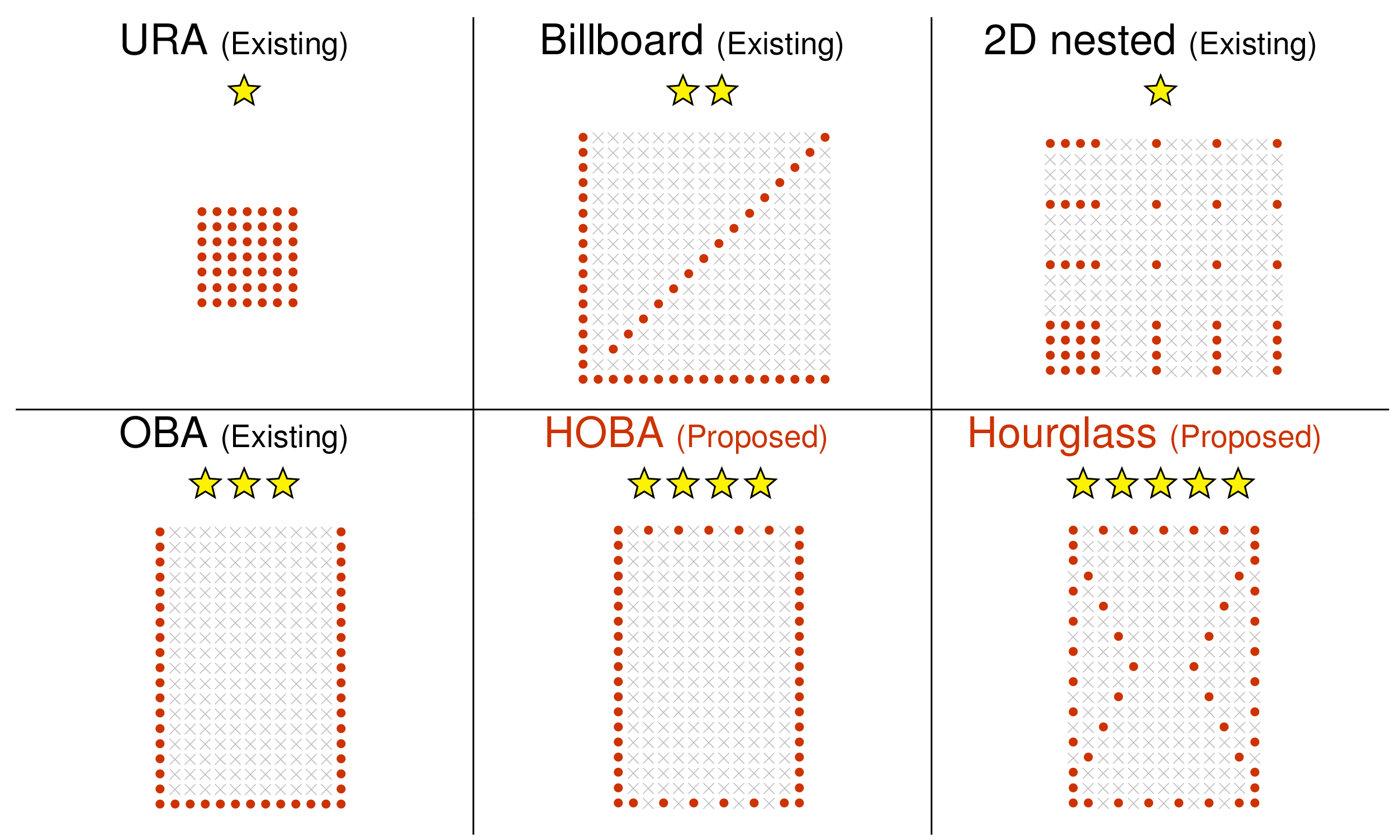Chun-Lin Liu – Topics – Hourglass Arrays (2D)
Sparse array design with reduced mutual coupling
Hourglass Arrays

Planar arrays with 49 sensors, including uniform linear arrays (URA), billboard arrays, 2D nested arrays, open box arrays (OBA), half open box arrays (HOBA), and hourglass arrays. (View larger)
Linear (1D) sparse arrays such as nested arrays and minimum redundancy arrays have hole-free difference coarrays
with  virtual sensor elements, where
virtual sensor elements, where  is the number of physical sensors.
The hole-free property makes it
easier to perform beamforming and DOA estimation in the coarray domain which behaves like an uniform linear
array. The
is the number of physical sensors.
The hole-free property makes it
easier to perform beamforming and DOA estimation in the coarray domain which behaves like an uniform linear
array. The  property implies that
property implies that  uncorrelated sources can be identified.
For the 2D case, planar
sparse arrays with hole-free coarrays having
uncorrelated sources can be identified.
For the 2D case, planar
sparse arrays with hole-free coarrays having  elements have also been known for a long time.
These include billboard arrays, open box arrays (OBA), and 2D nested arrays.
Their merits are similar to those of the 1D sparse
arrays mentioned above, although identifiability claims regarding
elements have also been known for a long time.
These include billboard arrays, open box arrays (OBA), and 2D nested arrays.
Their merits are similar to those of the 1D sparse
arrays mentioned above, although identifiability claims regarding  sources have to be handled with more care
in 2D.
sources have to be handled with more care
in 2D.
This paper introduces new planar sparse arrays with hole-free coarrays having  elements just like
the OBA, with the additional property that the number of sensor pairs with small spacings such as
elements just like
the OBA, with the additional property that the number of sensor pairs with small spacings such as  decreases,
reducing the effect of mutual coupling.
The new arrays include half open box arrays (HOBA),
half open box arrays with two layers (HOBA-2), and
hourglass arrays.
Among these, simulations show that hourglass arrays have the best estimation performance in presence of mutual coupling.
decreases,
reducing the effect of mutual coupling.
The new arrays include half open box arrays (HOBA),
half open box arrays with two layers (HOBA-2), and
hourglass arrays.
Among these, simulations show that hourglass arrays have the best estimation performance in presence of mutual coupling.
Our Papers
C.-L. Liu and P. P. Vaidyanathan, ‘‘Hourglass Arrays, and Other Novel 2D Sparse Arrays with Reduced Mutual Coupling,’’ IEEE Trans. on Signal Processing, vol. 65, no. 13, pp. 3369-3383, July 2017.
Sample code for Fig. 7. Please execute main_2D_DOA_estimation.m for the plots. (Last update: July 31, 2017)
C.-L. Liu and P. P. Vaidyanathan, ‘‘Two-Dimensional Sparse Arrays with Hole-Free Coarray and Reduced Mutual Coupling,’’ in Proc. of the 50th Asilomar Conference on Signals, Systems, and Computers, Pacific Grove, CA, Nov. 2016.
(The First Prize in Best Student Paper Award)